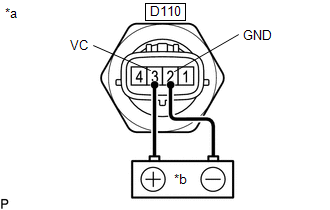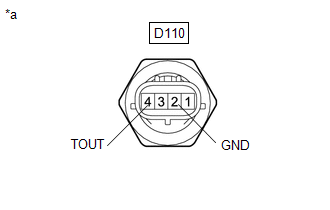Toyota Yaris: Oil Pressure And Temperature Sensor / Inspection
INSPECTION
PROCEDURE
1. INSPECT OIL PRESSURE AND TEMPERATURE SENSOR
(a) Check the oil pressure and temperature sensor output voltage.
| (1) Apply 5 V between terminals 3 (VC) and 2 (GND). NOTICE:
HINT: If a stable power supply is not available, connect 4 nickel-metal hydride batteries (1.2 V each) or equivalent in series. |
|
| (b) Measure the voltage between terminals. Standard Voltage:
*: The output voltage changes depending on the voltage applied to the terminals. If the result is not as specified, replace the oil pressure and temperature sensor. |
|
 Removal
Removal
REMOVAL PROCEDURE 1. REMOVE NO. 1 ENGINE UNDER COVER ASSEMBLY Click here
2. REMOVE OIL PRESSURE AND TEMPERATURE SENSOR (a) Disconnect the oil pressure and temperature sensor connector...
 Installation
Installation
INSTALLATION PROCEDURE 1. INSTALL OIL PRESSURE AND TEMPERATURE SENSOR (a) Apply adhesive to 2 or 3 threads of the oil pressure and temperature sensor...
Other information:
Toyota Yaris XP210 (2020-2025) Owner's Manual: Locking, Unlocking with Auxiliary Key
Turn the auxiliary key toward the front to lock, toward the back to unlock. Lock Unlock To lock All doors and the liftgate lock automatically when the driver’s door is locked using the auxiliary key. To unlock The driver’s door unlocks when the auxiliary key is turned briefly to the unlock position and then immediately returned to the center position...
Toyota Yaris XP210 (2020-2025) Reapir and Service Manual: Rear Window Defogger System does not Operate
DESCRIPTION An operation request signal is sent to the air conditioning amplifier assembly via LIN communication when the rear window defogger switch (air conditioning control assembly) is operated. When the air conditioning amplifier assembly receives the signal, it sends an operation request signal via CAN communication to the main body ECU (multiplex network body ECU)...
Categories
- Manuals Home
- Toyota Yaris Owners Manual
- Toyota Yaris Service Manual
- Brake System Control Module "A" System Voltage System Voltage Low (C137BA2)
- Immobilizer System
- Opening and Closing the Liftgate/Trunk Lid
- New on site
- Most important about car
Fuel-Filler Lid and Cap
WARNING
When removing the fuel-filler cap, loosen the cap slightly and wait for any hissing to stop, then remove it
Fuel spray is dangerous. Fuel can burn skin and eyes and cause illness if ingested. Fuel spray is released when there is pressure in the fuel tank and the fuel-filler cap is removed too quickly.


